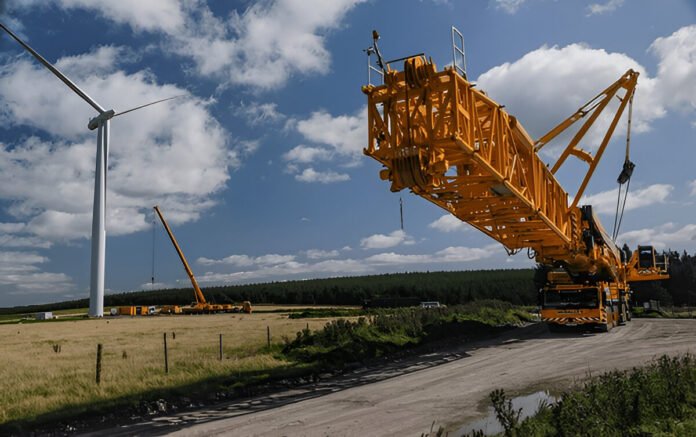Mobile cranes represent the backbone of modern construction and heavy lifting operations, offering unparalleled versatility across job sites. These engineering marvels combine mobility with impressive lifting capacity, making them indispensable for projects ranging from high-rise construction to industrial maintenance. However, their complex nature demands a thorough understanding of operational principles and safety protocols to ensure both efficiency and worksite protection. This comprehensive guide explores the critical aspects of mobile crane operations, providing professionals with actionable insights to optimize performance while maintaining the highest safety standards.
Table of Contents
Understanding Mobile Crane Classifications
The mobile crane family encompasses several distinct types, each designed for specific applications and working conditions. All-terrain cranes stand out for their dual capability of highway travel and off-road operation, featuring sophisticated suspension systems that adapt to various terrains. Truck-mounted cranes, commonly referred to as Hiab cranes, offer exceptional road mobility and quick setup, making them ideal for urban construction projects and logistics operations. Rough-terrain cranes specialize in off-road applications with their robust tires and enhanced stability systems, while crawler cranes provide unmatched stability on soft ground through their track-based movement system. The selection process must carefully consider factors including required lifting capacity, working radius, site accessibility, and transportation logistics to ensure optimal equipment deployment.
Pre-Operational Planning Essentials
Thorough preparation forms the foundation of successful mobile crane operations. Site evaluation begins with a comprehensive assessment of ground conditions, requiring verification of soil bearing capacity and identification of potential hazards such as underground utilities or unstable surfaces. Overhead clearance analysis must account for power lines, communication cables, and surrounding structures, with particular attention to minimum approach distances for electrical hazards. Load characteristics including weight, dimensions, and center of gravity must be precisely calculated and cross-referenced with the crane’s load chart. The development of a detailed lift plan serves as a critical roadmap, documenting equipment configuration, rigging specifications, personnel assignments, and contingency measures for unexpected situations.
Crane Setup and Stabilization Procedures
Proper crane setup transforms potential hazards into controlled operations. Outrigger deployment requires meticulous attention, ensuring full extension on properly prepared surfaces with adequate cribbing when necessary. The leveling process demands precision, with modern cranes featuring electronic indicators that supplement traditional bubble levels for enhanced accuracy. Counterweight installation follows manufacturer specifications exactly, with verification of secure attachment before commencing operations. Boom assembly and rigging require systematic inspection of all components, with particular focus on wire rope condition, hydraulic connections, and structural integrity of lifting attachments. The setup phase concludes with functional testing of all safety systems including load moment indicators, anti-two-block devices, and emergency stop mechanisms.
Load Handling Techniques for Optimal Efficiency
Mastering load dynamics separates proficient operators from merely competent ones. The pick-and-carry process begins with careful positioning directly above the load’s center of gravity, ensuring balanced stress distribution throughout the lift. Smooth operation of controls prevents dangerous load swinging, with particular attention to gradual acceleration and deceleration during movement. Boom manipulation techniques vary by crane type, with telescopic booms requiring different handling than lattice configurations. Operators must continuously monitor load position relative to obstructions, maintaining clear communication with ground personnel through standardized hand signals or radio protocols. Wind conditions require constant evaluation, with operational adjustments or cessation when gusts exceed manufacturer recommendations.
Advanced Safety Protocols and Risk Mitigation
Comprehensive safety measures form an impenetrable barrier against potential accidents. Operator certification represents just the starting point, with ongoing training programs keeping skills sharp and knowledge current regarding evolving regulations. Load management extends beyond simple weight calculations to include dynamic factors such as wind resistance, movement forces, and potential ice accumulation in cold climates. Emergency preparedness encompasses not only equipment failure scenarios but also medical emergencies and environmental hazards. The implementation of redundant safety systems, including secondary load holding devices and backup communication methods, provides additional layers of protection against single-point failures.
Maintenance Practices for Long-Term Reliability
Preventive maintenance serves as the most effective strategy against unplanned downtime. Daily inspections follow a regimented checklist covering fluid levels, structural components, and operational systems. Periodic maintenance intervals adhere strictly to manufacturer recommendations, with particular attention to wear items such as wire ropes, sheaves, and hydraulic seals. Documentation practices create a comprehensive service history, enabling predictive maintenance through analysis of recurring issues and component lifespan trends. Off-season storage protocols protect sensitive components from environmental damage, ensuring readiness when the crane returns to service.
Navigating Regulatory Compliance Requirements
The regulatory landscape governing mobile crane operations continues to evolve. OSHA standards establish baseline requirements for equipment operation and worksite safety, while ANSI guidelines provide detailed technical specifications for equipment design and use. Local jurisdictions often impose additional permitting requirements, particularly for operations near public thoroughfares or in environmentally sensitive areas. Documentation practices must maintain current records of inspections, certifications, and incident reports, with particular attention to audit trails demonstrating compliance with all applicable regulations. The development of strong relationships with regulatory officials facilitates smoother permitting processes and provides valuable insights into upcoming regulatory changes.
Technological Advancements in Crane Operations
Modern mobile cranes incorporate sophisticated technologies that enhance both safety and efficiency. Load monitoring systems now provide real-time data on weight distribution and center of gravity, with visual and audible alerts for approaching capacity limits. Stability control systems automatically adjust to changing conditions, compensating for wind forces and ground variations. Telematics platforms enable remote monitoring of equipment status, facilitating predictive maintenance and optimizing fleet utilization. Augmented reality systems assist operators in load placement, projecting virtual markers onto real-world environments to improve precision in complex lifts.
Crew Coordination and Communication Best Practices
Effective teamwork transforms individual competence into collective excellence. The pre-lift briefing establishes clear understanding of roles, responsibilities, and emergency procedures among all team members. Communication protocols standardize terminology and methods, whether through hand signals, radios, or advanced digital systems. The establishment of designated safe zones and clear sight lines prevents personnel from inadvertently entering danger areas. Continuous situational awareness among all team members creates a collaborative safety net, where multiple sets of eyes monitor different aspects of the operation simultaneously.
Environmental Considerations in Crane Operations
Sustainable practices increasingly influence modern crane operations. Fuel management strategies reduce emissions through optimized engine performance and idle reduction techniques. Spill prevention measures protect job sites from fluid leaks, with secondary containment systems for refueling operations. Noise abatement techniques minimize disturbance to surrounding communities, particularly for urban projects with strict decibel limits. The adoption of alternative power sources, including hybrid and electric crane models, continues to grow as technology advances and environmental regulations tighten.
Post-Operation Procedures and Continuous Improvement
The conclusion of lifting operations initiates important follow-up activities. Equipment shutdown follows a systematic process to ensure all components are properly secured and protected. Post-operation inspections identify any developing issues before they become serious problems, with particular attention to components that experienced unusual stress during the lift. Debriefing sessions capture lessons learned, documenting both successful innovations and areas requiring improvement for future reference. Data collected from the operation feeds into long-term performance analysis, identifying trends that can inform equipment replacement decisions and training priorities.
Conclusion: The Path to Operational Excellence
Achieving excellence in mobile crane operations requires the harmonious integration of technical knowledge, practical skills, and unwavering commitment to safety. The most successful operations emerge from organizations that view their cranes not as simple tools, but as complex systems requiring comprehensive management. By embracing continuous learning, technological innovation, and cultural dedication to safety, crane professionals can elevate their operations to new levels of efficiency and reliability. The ultimate measure of success lies not just in completed lifts, but in the development of sustainable practices that protect both personnel and equipment while delivering consistent project results. In an industry where margins for error shrink as loads grow larger, this holistic approach to mobile crane operations establishes the foundation for long-term success in an increasingly demanding professional landscape.








